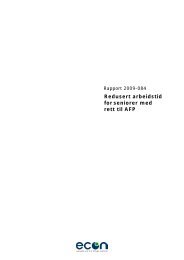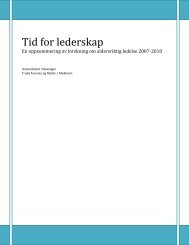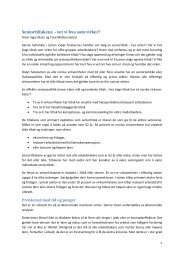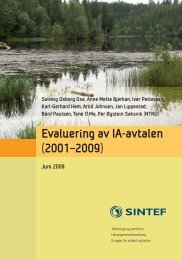Per Erik Solem
Per Erik Solem
Per Erik Solem
Create successful ePaper yourself
Turn your PDF publications into a flip-book with our unique Google optimized e-Paper software.
<strong>Per</strong> <strong>Erik</strong> <strong>Solem</strong><br />
NOVA<br />
Norway<br />
Ageism and discrimination of older workers in Norway<br />
Objectives<br />
The concept of ageism is used in many different ways in the literature. A conceptual analysis<br />
done by Iversen, Larsen & <strong>Solem</strong> (2009) clarifies the dimensions and presents a new<br />
definition. The paper will present this definition and exemplify with empirical research on one<br />
dimension: explicit negative discrimination of older workers in Norway.<br />
Methods<br />
The empirical part is based upon the Norwegian Senior Policy Barometer for every year from<br />
2003 to 2009. Data for two barometers are collected each year, one barometer for employed<br />
persons in general (N= about 1000 each year, summing up to 7016) and one for managers (N=<br />
about 750 each year, summing up to 5309). Data are collected on national samples by the<br />
marked research institute Synovate for the Centre for Senior Policy.<br />
The questions:<br />
- How often have you had the experience that discrimination takes place in working life,<br />
because of a) Gender, b) Age? (very often / often / now and then / seldom / never)<br />
- How often have you had the experience that the following situations happen in working life?<br />
(very often / often / now and then / seldom / never)<br />
a) Older workers are passed over for appointments and internal recruitments<br />
b) Older workers are more seldom permitted to attend to courses and training during working<br />
hours<br />
c) Younger workers are preferred when new technology or new working methods are<br />
introduced<br />
d) Older workers receive less wage increase than younger workers<br />
- About how old would a qualified applicant to a position be before you hesitate to call him or<br />
her in for an interview, because of age?<br />
The questions ask about the experiences of the respondent, however not about the<br />
respondents' experience of being exposed to age discrimination themselves. The main reason<br />
for asking indirectly is that we wanted workers and managers to be asked the same questions.<br />
And since age discrimination is illegal, questions to managers on how often age<br />
discrimination takes place in their company, would be prone to underreporting.
Thus, the questions used are not measuring the prevalence of age discrimination. However, it<br />
is possible to compare age discrimination with sex discrimination. The questions also give an<br />
indication of the relative prevalence of different types of age discrimination and of possible<br />
changes during the study period.<br />
Results<br />
Iversen et al. (2009) refer to twenty-seven different definitions of ageism, which is used in the<br />
research literature. The definitions cover, to varying degrees, four dimensions:<br />
- The three classic components of attitudes: the cognitive (stereotypes), affective (prejudice)<br />
and behavioral (discrimination), - positive and negative ageism, - implicit and explicit ageism,<br />
- ageism on micro level (individual), meso level (e.g. intergroup segregation) and on macro<br />
level (e.g. legislation on mandatory retirement).<br />
Ageism is defined as negative or positive stereotypes, prejudice and/or discrimination against<br />
(or to the advantage of) elderly people on the basis of their chronological age or on the basis<br />
of a perception of them as being 'old' or 'elderly'. Ageism can be implicit or explicit and can<br />
be expressed on a micro-, meso- or macro-level.<br />
The results from the Norwegian Senior Policy Barometer show only small changes from 2003<br />
to 2009. Changes are statistically significant for managers, but not for the age group of<br />
workers susceptible for discrimination, the seniors 55 years and above. In 2009 managers<br />
report less age discrimination than in 2003, while the seniors have observed no change.<br />
Managers have over the whole period lower estimates than senior workers, of how often they<br />
have observed that age discrimination takes place. For example, in 2009 23 per cent of the<br />
managers say they at least now and then have experienced that older workers are passed over<br />
for appointments and internal recruitments, compared to 35 per cent of seniors saying the<br />
same. For one question, that younger workers are preferred when new technology or new<br />
working methods are introduced, managers have more negative estimates than seniors. In<br />
2009, 58 per cent and 52 per cent of mangers and seniors respectively report this to happen at<br />
least now and then. The difference is small, but probably seniors themselves often have low<br />
confidence in their ability to use new technologies.<br />
Conclusions<br />
When studying ageism and age discrimination it is of great value to be clear on what<br />
dimensions of ageism are included in the study. The empirical part of this paper study the<br />
behavioral part of attitudes; age discrimination, and show small changes over the study<br />
period. Managers estimate discrimination of older workers to happen less often than do<br />
seniors.<br />
(Further analyses will expand on conclusions)
















